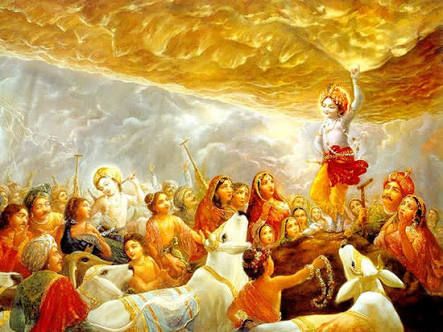GOVARDHANA Through the Guru\’s discipline, Krishna lifted the Govardhana (mountain). (Maru M. l, p. 1041) Govardhan-dhari (One who holds up the mountain Govardhana)… (Maru M. 5, p. 1082) Govardhana is the name of a mountain in Vrindavana near Mathura. Once Krishna induced the cowherds and Gopis to worship this mountain instead of the god Indra. On this Indra was greatly enraged and caused a heavy rain to deluge the area. In order to remove the distress of the inhabitants, Krishna held up the mountain as an umbrella to shelter them ane their cattle, on his little finger for seven days. The baffled Indra paid homage to Krishna.
References :
1. Kohli, Surindar Singh (ed), Dictionary of Mythological References in Guru Granth Sahib, 1993
Govardhana, also known as Govardhan Hill, is a prominent sacred site in Hindu mythology, closely associated with the divine deeds of Lord Krishna. Situated near Vrindavan in Uttar Pradesh, India, Govardhana is not only a geographical landmark but also a powerful symbol of devotion, protection, and Krishna’s teachings on humility and reverence for nature.
The Legend of Govardhana
The story of Govardhana is most famously recounted in the Bhagavata Purana. During Krishna’s time in Gokul, the villagers of Vrindavan were preparing grand rituals to honor Indra, the king of gods, for bringing rain. Krishna advised them to redirect their worship toward Govardhana Hill and nature, which truly sustained their lives by providing food, shelter, and resources. This act emphasized Krishna’s teachings on simplicity, gratitude, and recognizing the divine in all aspects of creation.
Offended by the villagers’ shift in worship, Indra unleashed a torrential storm to punish them. In response, Krishna lifted Govardhana Hill with his little finger and held it aloft for seven days and nights, offering shelter to the villagers and their cattle beneath the hill. This miraculous feat demonstrated Krishna’s role as the divine protector and established Govardhana as a sacred site.
Govardhana as a Symbol
In Hindu tradition, Govardhana symbolizes:
- Divine Grace: Krishna’s act of lifting the hill represents the constant protection and care the Divine provides to all devotees.
- Reverence for Nature: Worshipping Govardhana instead of conducting elaborate rituals for Indra reflects Krishna’s teachings on honoring the natural world and practicing humility.
- Faith and Devotion: The villagers’ trust in Krishna’s protection underlines the importance of surrendering oneself to the Divine. Modern Worship and Rituals
Govardhana is still revered today, and thousands of devotees visit the site annually. One of the most prominent rituals is the Govardhana Puja, celebrated during Diwali, in which devotees honor Govardhana Hill by offering food and prayers. The parikrama (circumambulation) around Govardhana Hill is a significant act of devotion, symbolizing spiritual surrender and gratitude.
Govardhana continues to inspire devotion and represents the eternal connection between humanity and the Divine, underscoring Krishna’s teachings of humility, simplicity, and harmony.



